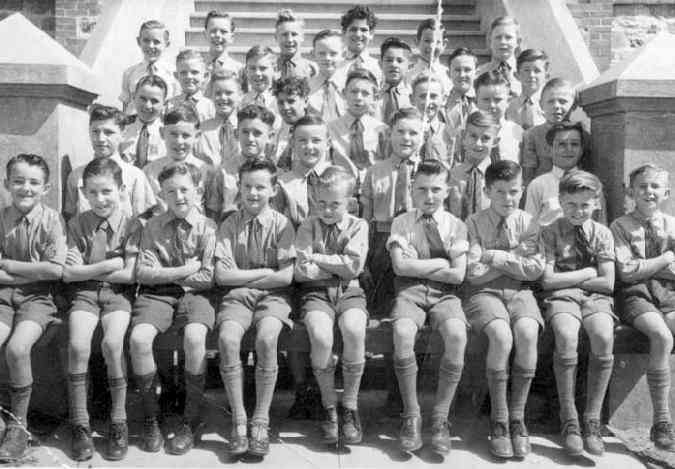
Australian School Uniform Garments: Footwear

Figure 1.--We are not sure what kind of school this is. The boys look to be about 9 years old. We would guess the photograph was taken in the 1950s. Note that only one boy wears sandals. British=stle closed-toe sandalswere not nearly as popular in Australia as they were in Britain.
|
|
Australian boys have worn a wide range of foowear. In part because of the climate, many children went to school barefoot. Family income was also a factor. We note many Australian boys going barefoot to school in the 19th century. This was especially common in rural primary schools. Going barefoot was still common in the first half of the 20th century. Boot-like high-top shoes were common at the turn of the 20th century. Gradualy low-cut oxfords became standard. We note some primary boys wearing English-style school sandals, the ones with the "t"-strap. They were, however, never nearly as popular as in England. More common were open-toe sandals which were commonly called Roman sandals and worn during the summer term. Almost always. at least vwith the boys, they were worn as part of a school uniform. They were also worn by girls. Many schools required children to wear leather shoes, often black leather shoes. Australian children by the 1970s began wearing sneakers to school. Sneakers were an American fashion influence, but did not become popular in Australia until the early 70s. For the most part they are still only allowed at public schools whichbdid not have uniforms. They became common at schools that did not have uniforms.
Chronology
Australian boys have worn a wide range of foowear over time. In part because of the climate, many children went to school barefoot. Family income was also a factor. We note many Australian boys going barefoot to school in the 19th century. This was especially common in rural primary schools. Going barefoot was still common in the first half of the 20th century.Weearing shoes became much more standard in the 1960s. The increasing influence of America was a factor here and school uniforms and clothing in general were become more informal.
Australian children have worn British styled school uniforms. A major exeption was footwear. Here there were substantial differences. Many Australian children went to school barefooy. We also bsee a vartriety of footwear types. Boot-like high-top shoes were common at the turn of the 20th century. Gradualy low-cut oxfords became standard. We only note leathercshoes until the 1970s. The only exception was that boys and girls did wear plymsols for gyym. We note some primary boys wearing English-style school sandals, the ones with the "t"-strap. They were, however, never nearly as popular as in England. More common were open-toe sandals which were commonly called Roman sandals and worn during the summer term. Almost always. at least vwith the boys, they were worn as part of aschool uniform. They were also worn by girls. Many schools required children to wear leather shoes, often black leather shoes. Australian children by the 1970s began wearing sneakers to school. Sneakers were an American fashion influence, but did not become popular in Australia until the early 70s. For the most part they are still only allowed at public schools which did not have uniforms. They became common at schools that did not have uniforms.
Seasonality
Australia does not have severe winters. Thus children could go bbarefoot all tyear round, although it was much more common during the warmer months. Sandals were also seasonal.
Gender
Uniforms
HBC

Related Chronolgy Pages in the Boys' Historical Web Site
[Main Chronology Page]
[The 1880s]
[The 1930s]
[The 1940s/a>]
[The 1950s]
[The 1960s]
[The 1970s]
[The 1980s]
Related Style Pages in the Boys' Historical Web Site
[Main school uniform page]
[Main country page]
[Long pants suits]
[Short pants suits]
[Socks]
[Eton suits]
[Jacket and trousers]
[Blazer
[School sandals]
Navigate the Boys' Historical Clothing School Uniform Pages
[Return to the Main Australian School Uniform Garment Page]
[Return to the Main Australia page]
[England]
[France]
[Germany]
[Italy]
[Japan]
[New Zealand]
[Scotland]
[United States]
Navigate the Boys' Historical Clothing Web Page
[Introduction]
[Activities]
[Biographies]
[Chronology]
[Cloth and textiles]
[Clothing styles]
[Countries]
[Topics]
[Bibliographies]
[Contributions]
[FAQs]
[Glossaries]
[Images]
[Links]
[Registration]
[Tools]
[Boys' Clothing Home]
Created: May 1, 2004
Last updated: 1:43 AM 7/25/2010




